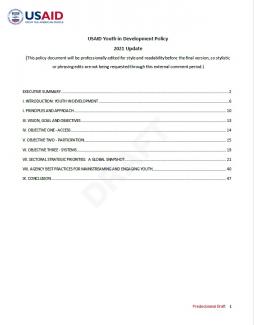The USAID Youth in Development Policy was first launched in 2012 and was the first of its kind by bi-lateral donors.Ten years later, USAID is updating this policy to ensure its relevance in a rapidly evolving world where authoritarian leaning regimes are on the rise, the world struggles to recover from the most significant pandemic in a century, significant and growing threats from climate change, digital technology has generated benefit but also harm, and research provides us new insights on evidence-based Positive Youth Development (PYD) approaches to effective programming.Today, there are 2.4 billion young people ages 10-29 living in the world 1 – the largest youth population in history.According to the United Nations, 9 out of 10 youth live in less developed countries and are affected disproportionately by poverty, conflict, violence, poor health, unemployment, and exclusion. Evidence shows that if we invest effectively in youth’s integrated development and engage them as partners in development, humanitarian, and peacebuilding efforts, the current generation will contribute to greater economic growth, democracy, and stability and advance self-reliance for their communities and nations. Conversely, if youth remain marginalized, these development areas will likely remain stagnant or even decline. USAID believes in the importance of partnering with and integrating youth in all their diversity into development and shaping their own future.Youth are not only key drivers of prosperity, security, and democracy in their countries, but are also a vital resource to meet local, national, and global peace, security, and economic goals. USAID also believes in supporting youth development due to their unique needs and experiences and supporting them as citizens, deserving to be healthy, educated, employed, and engaged with the community around them.
(894.23 KB)

